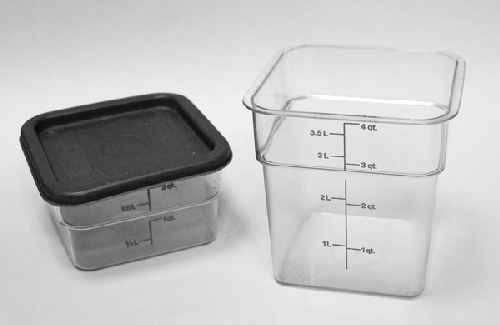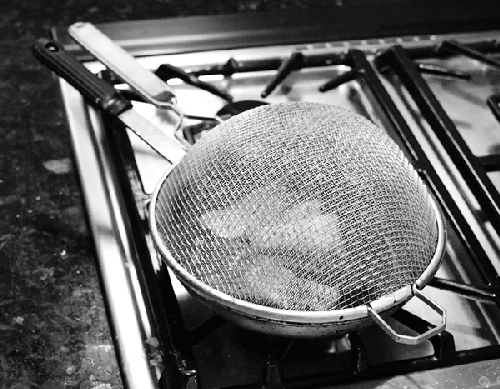2. Standard Kitchen Equipment
There is a balance between having the right tool for the right job and having too much
stuff on hand. When looking at a potential kitchen tool, consider if you can do the task
it’s intended for with a tool you already have, and whether the new gizmo is a multitasker
capable of solving more than one problem.
2.1. Storage containers
While you can use consumer-grade plastic containers, the commercial-grade
polycarbonate containers used in the restaurant industry are great: they’re rugged
enough to last a lifetime, can handle hot liquids, and are designed for holding the
larger quantities you’ll be handling for group cooking. Search online for Cambro’s
CamSquare containers.
Ubiquitous in commercial kitchens, CamSquare containers are
affordable, practically indestructible, and add a certain geek flair. You can flip
the lid over and use it as an impromptu cutting board as well.

2.2. Strainers
Look for a strainer that has a metal mesh and a handle long enough to span your
sink. Avoid strainers that have plastic parts; plastic isn’t as strong or heat resistant
and will eventually break. In addition to the normal application of straining cooked
foods like pasta or washing berries, a metal strainer can double as a splatter guard
when inverted above a frying pan. Depending on the types of food you are cooking, you
might find a spider—a specialized spoon with a wide shallow mesh bowl and a long
handle—helpful for scooping out items from pots of boiling water.
Note:
When straining out pasta from boiling water, pour away from
yourself to avoid steam burns.
You can use a strainer as a splatter guard while pan-frying items such
as salmon. Make sure your strainer is wire mesh and has no plastic
parts.

2.3. Mixers & co.
For
baking, a handheld mixer or stand mixer is pretty much indispensable. Sure, you can use
a whisk or a spoon, but when it comes to creaming together butter and sugar, you’ll get
better results with an electric mixer that can whip microscopic air bubbles into the
mix. Besides a mixer, there are a few other electric devices that are worth their
counter space.

Immersion blender. Skip the normal blender and go
for an immersion blender. Sometimes called a stick
blender, the blade part of the blender is mounted on a handle and immersed
into a container that holds whatever it is you want to blend. When making soup, for
example, instead of transferring the soup from pot to blender for puréeing, you take the
immersion blender and run it directly in the pot. Quicker to use, easier to wash.
Food processor. While not an essential, there are
times when a food processor makes quick work of otherwise laborious tasks—for example,
making pesto or slicing 10 pounds of onions or pulsing pie dough to incorporate flour
and butter. They’re expensive, though, and take up space. You might opt for a mandolin,
instead, which can also be used to quickly make large piles of julienned
(matchstick-cut) veggies.
Note:
Sad but true: the julienned strips you see in restaurants aren’t lovingly cut by
hand.
Rice cooker with slow-cook mode. I’m in love with
my rice cooker. Actually, that’s not true; I’m in love with the slow-cook mode of my
rice cooker, and you should be, too. Some chemical processes in
cooking require a long period of time at a relatively specific temperatures. This is why
you should make room for a rice cooker with a slow-cook mode: you can safely leave it on
overnight, or even for a few days, without worrying about either the utility bill or the
house burning down (something that you shouldn’t do with almost any other source of heat
in the kitchen). This handy appliance makes an entire class of dishes (braised short
ribs, duck confit, beef stew) trivially easy. You could just get a slow cooker, but a
rice cooker with slow-cook mode will also come in handy for those occasions when you
actually want to make rice.